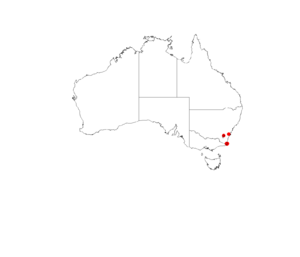Narrabarba wattle facts for kids
Quick facts for kids Narrabarba wattle |
|
|---|---|
| Conservation status | |
| Scientific classification | |
| Genus: |
Acacia
|
| Species: |
constablei
|
 |
|
| Occurrence data from AVH | |
The Narrabarba wattle, also known as Acacia constablei, is a special type of Acacia plant found only in eastern Australia. It's considered a vulnerable species, which means it needs protection because its numbers are low.
What Does the Narrabarba Wattle Look Like?
The Narrabarba wattle is usually a shrub or a small tree. It can grow from 1 to 3 metres (3 to 10 ft) tall, but sometimes it can reach up to 7 m (23 ft)! It has smooth bark that might look a bit patchy or light grey. Its branches are often ridged.
This plant usually blooms, or flowers, between June and August. Sometimes, it can even bloom earlier, between February and March. Its flowers are pale yellow to creamy white and look like small, round balls.
The leaves of the Narrabarba wattle are feathery-shaped and are about 2 to 5 cm (0.79 to 1.97 in) long. Each leaf has many smaller parts called leaflets, usually 6 to 14 pairs. These leaflets are made up of even tinier parts called pinnules, with 9 to 30 pairs on each leaflet.
After the flowers bloom, the plant grows dark brown to black seed pods. These pods are flat and straight, measuring about 3 to 7 cm (1.2 to 2.8 in) long and 6 to 9 mm (0.24 to 0.35 in) wide. They are covered in short, fine hairs.
Naming the Narrabarba Wattle
The Narrabarba wattle was first officially described by a botanist named Mary Tindale in 1980. She wrote about it in a science journal called Telopea.
Later, in 2003, another botanist named Leslie Pedley changed its name to Racosperma constablei. But then, in 2006, it was changed back to its original name, Acacia constablei.
The second part of its scientific name, constablei, is a special way to honor a person. It was named after Ernest Francis Constable. He used to collect plants for the Royal Botanic Garden, Sydney.
Where Does the Narrabarba Wattle Live?
The Narrabarba wattle grows in a very small area in southwestern New South Wales, Australia. Most of these plants are found about 20 km (12 mi) south of a town called Eden.
The largest group of Narrabarba wattles lives in the Nadgee State Forest. They are also found within the area of the proposed Narrabarba Hill Flora Reserve, covering about 3 km (1.9 mi). There's also a smaller group of these plants in Ben Boyd National Park.
These wattles like to grow on rocky hilltops made of a type of rock called rhyolite and apatite. The soil there is usually sandy and doesn't have many nutrients. Sometimes, they can also be found in brown to black loamy soils. Scientists believe there are about 6,000 Narrabarba wattle plants in total, spread across an area of about 4 ha (9.9 acres).


